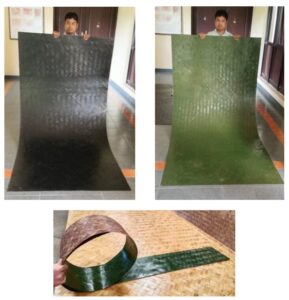Bamboo farming is emerging as a highly profitable and sustainable agricultural business in India. With the increasing demand for bamboo-based products in construction, furniture, paper, textiles, and even biofuel, investing in bamboo farming can be a smart choice. This guide will walk you through everything you need to know about starting your own bamboo farm in India, from selecting the right species to harvesting and marketing your bamboo.
1. Why Start a Bamboo Farm in India?
A) High Demand and Profitability
India is one of the largest consumers of bamboo, using it for furniture, construction, handicrafts, and paper production.
Bamboo farming has a high return on investment, as a well-maintained farm can generate profits for over 30-40 years.
Governments and private industries are actively promoting bamboo cultivation as part of their sustainability initiatives.
B) Fast-Growing and Sustainable
Bamboo is one of the fastest-growing plants in the world, with some species growing up to 3 feet per day.
It requires minimal water, no pesticides, and helps in soil conservation and carbon sequestration.
A single bamboo clump can regenerate for years without replanting, making it a long-term investment.
C) Government Support & Subsidies
The Indian government, through the National Bamboo Mission (NBM), provides financial assistance for bamboo farming.
States like Assam, Tripura, Madhya Pradesh, and Maharashtra offer additional incentives for bamboo cultivation.
2. Choosing the Right Bamboo Species
The success of your bamboo farm depends on selecting the right species for your region and intended use.
A) Best Bamboo Varieties for Commercial Cultivation
Bambusa balcooa – Used for construction and furniture, high-yield species.
Dendrocalamus asper – Large-sized bamboo, ideal for furniture and construction.
Bambusa tulda – Preferred for paper and handicrafts.
Dendrocalamus strictus – Used in biomass energy production and fencing.
Phyllostachys edulis (Moso Bamboo) – Grown for timber and edible shoots.
B) Climate and Soil Requirements
Bamboo thrives in tropical and subtropical climates with temperatures between 15°C to 40°C.
Requires well-drained, loamy, or sandy soil with a pH range of 5.5 to 6.5.
Avoid waterlogged or highly saline soils.
3. Steps to Start Your Bamboo Farm
A) Land Preparation and Planting
Choose a suitable location – Preferably near water sources with good sunlight exposure.
Prepare the soil – Remove weeds, till the land, and apply organic compost.
Spacing and planting – Plant bamboo seedlings at 4×4 meters spacing for optimal growth.
Watering and irrigation – Bamboo requires frequent watering in the first year but becomes drought-resistant later.
Fertilization – Use organic manure or vermicompost for better yield.
B) Bamboo Plantation Care & Maintenance
Weeding – Regularly remove weeds to prevent competition for nutrients.
Mulching – Helps retain soil moisture and control weed growth.
Pruning – Remove dead or weak shoots to enhance productivity.
Pest and Disease Control – Bamboo is naturally resistant to most pests, but fungal infections may occur in humid conditions.
4. Harvesting and Processing Bamboo
Bamboo is ready for harvesting within 3-5 years, depending on the species.
Harvest mature bamboo culms (3-6 years old) for best strength and durability.
Use proper cutting techniques to allow regrowth and maintain sustainability.
After harvesting, bamboo can be treated with borax solutions to prevent insect damage.
5. Market Opportunities & Selling Your Bamboo
Bamboo has a wide range of applications, ensuring multiple revenue streams for farmers.
A) Industries That Buy Bamboo
Furniture & Handicrafts Industry – Bamboo is used for making chairs, tables, and home décor items.
Paper & Pulp Industry – Bamboo fibers are a key raw material for paper manufacturing.
Construction Industry – Bamboo is used for scaffolding, flooring, and roofing.
Textile Industry – Bamboo fibers are converted into eco-friendly fabrics.
Energy & Biofuel Industry – Bamboo is used for biomass fuel and charcoal production.
B) Selling Channels for Bamboo Farmers
Direct to manufacturers – Sell bamboo culms to industries that use raw bamboo.
Government Schemes & Cooperatives – Enroll in government programs that support bamboo farming.
Online marketplaces – Platforms like IndiaMART and TradeIndia facilitate bulk sales of bamboo.
Export Market – Countries like China, Japan, and Europe have a high demand for bamboo products.
6. Investment, Costs, and Profits in Bamboo Farming
A) Initial Investment & Costs
| Expense | Estimated Cost (per acre) |
|---|---|
| Land Preparation | ₹10,000 – ₹15,000 |
| Bamboo Seedlings (400-500 plants) | ₹20,000 – ₹30,000 |
| Irrigation Setup | ₹15,000 – ₹25,000 |
| Fertilizers & Maintenance | ₹10,000 – ₹20,000 per year |
| Labor Costs | ₹20,000 – ₹30,000 per year |
B) Profit Potential
A well-maintained bamboo farm can yield 10-20 tons per acre per year.
The market price of bamboo varies from ₹1,500 to ₹5,000 per ton, depending on quality and demand.
Farmers can earn ₹3-6 lakh per acre annually after full maturity.
7. Government Support & Bamboo Farming Subsidies
National Bamboo Mission (NBM): Provides up to ₹50,000 per hectare for bamboo cultivation.
State Government Grants: Some states offer additional financial support and buyback schemes.
Bank Loans & NABARD Support: Bamboo farming is eligible for agricultural loans under NABARD schemes.
8. Conclusion: Why You Should Start Bamboo Farming Today
Bamboo farming in India presents a profitable and eco-friendly opportunity for entrepreneurs and farmers. With its low maintenance, fast growth, and high market demand, bamboo cultivation is a sustainable investment for the future.
If you’re interested in starting a bamboo farm, now is the perfect time to take advantage of government incentives, increasing demand, and eco-conscious markets.
🌱 Start your bamboo farming journey today and be part of India’s green revolution! 🌿





